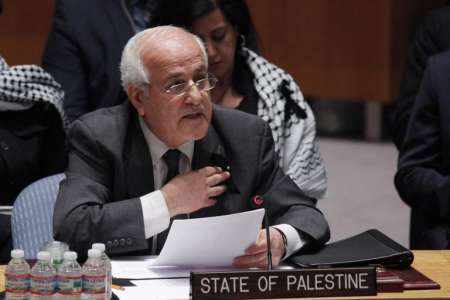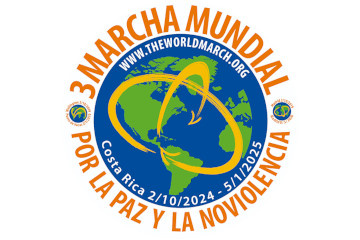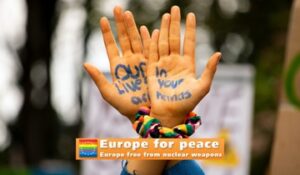Por Nicolas Boeglin*
El voto del Consejo de Seguridad acaecido el 30 de diciembre pasado no permitió que se adoptara una resolución propuesta por Jordania sobre Palestina. A diferencia de otros ejercicios de este tipo, Estados Unidos esta vez adujo “no haber ejercido su derecho a veto”, al no reunirse nueve votos afirmativos dentro del Consejo. Una afirmación que amerita algunos bemoles y un hecho que merece ser analizado desde una perspectiva histórica.
En estas últimas semanas del año 2014, diversos sectores solicitaron a Estados Unidos que no recurriera al veto de cara a la presentación de una resolución en el seno del Consejo de Seguridad sobre Palestina (ver por ejemplo llamado de la ONG Jewish Voice for Peace). Como bien se sabe, se trata de un privilegio jurídicamente consagrado que ostentan desde 1945 los cinco Miembros Permanentes del Consejo de Seguridad (China, Estados Unidos, Francia, Reino Unido y Rusia) para evitar que el Consejo adopte una propuesta de resolución: independientemente del número de votos favorables con el que cuente un texto, un voto negativo de uno de ellos impide la aprobación de la decisión. Para ser considerada como adoptada, una decisión del Consejo de Seguridad debe contar con al menos 9 votos, incluyendo el voto afirmativo de los cinco miembros permanentes del Consejo de Seguridad, según lo estipula el artículo 27 de la Carta de las Naciones Unidas.
Breve puesta en perspectiva histórica:
Un estudio publicado en el Anuario Colombiano de Derecho Internacional (Nota 1) indica que para el período 1984-2007, Estados Unidos recurrió 32 veces a ejercer su veto de manera solitaria en el seno del Consejo de Seguridad. De estos 32 vetos, 25 de ellos se relacionan directamente con textos sobre acciones armadas u otras acciones de Israel en Gaza, en Cisjordania o en el sur del Líbano (ver tabla insertada en el precitado artículo, pp. 78-82). Durante la administración del Presidente G.W Bush, Estados Unidos la uso en nueve oportunidades y solo nos referiremos a detallar las cuatro últimas de manera a preservar el interés de los lectores poco familiarizados con este tipo de textos:
- en noviembre del 2006 (ver texto propuesto de resolución S/2006/878) la propuesta fue rechazada, según acta S/PV/5565 con 10 votos a favor, uno en contra y 4 abstenciones: Dinamarca, Eslovaquia, Japón y Reino Unido;
- en julio del 2006 (ver texto propuesto de resolución S/2006/508) el texto fue rechazado según acta S/PV/5418 en sesión privada de la que no se tiene mayor detalle;
- en octubre del 2004 (ver texto propuesto de resolución S/2004/783), la propuesta es rechazada, según acta S/PV/5051 por 11 votos a favor, uno en contra y 3 abstenciones: Alemania, Reino Unido y Rumanía;
- en marzo del 2004 (ver texto propuesto de resolución S/2004/240) el texto fue rechazado según acta S/PV/4934 por 11 votos a favor, uno en contra y 3 abstenciones: Alemania, Reino Unido y Rumanía.
La primera vez que la administración del actual Presidente Barack Obama recurrió al veto para evitar una resolución sobre Palestina fue el 18 de febrero del 2011: se puede leer el texto propuesto S/2011/24 aquí y leer el acta S/PV/6484 que arroja el siguiente resultado: 14 votos a favor y uno en contra. Si se compara con los ejercicios realizados en anteriores votaciones, se trató de uno de los peores resultados jamás alcanzado por la diplomacia norteamericana. El resultado causó un malestar interno en el aparato norteamericano y reacciones airadas de muchos Estados y de varios otros sectores, incluyendo la de una ONG como Amnistía Internacional (ver comunicado oficial de AI): es mediante este tipo de veto que la colonización de Israel en territorios palestinos no ha podido históricamente ser condenada por parte del Consejo de Seguridad (a la fecha sigue sin serlo). La misma actitud de Estados Unidos se dio a finales del 2012, con relación esta vez a 3000 asentamientos nuevos en Cisjordania y en Jerusalén Oriental. No obstante, una innovación técnica instaurada por la delegación de Estados Unidos, el «veto implicito» impidió tan siquiera llegar a una votación (Nota 2).
En las últimas semanas y días del 2014, la prensa se hizo nuevamente eco de la amenaza de veto por parte de Estados Unidos con relación a la propuesta de resolución formalmente presentada por Jordania a mediados de diciembre del 2014. Por su parte diversos intelectuales y comentadores reiteraron su llamado para que Estados Unidos abandonase la práctica del veto: el pasado 19 de diciembre, se leyó incluso en un medio israelí como Haaretz un artículo de opinión titulado: “Obama, do another Cuba: Lift the perennial American veto for Israel in the UN”. El día anterior un artículo de opinión (en el mismo Haaretz) usaba un titular un tanto más provocador: “The U.S. must wean itself from its imbecilic automatic veto policy”.
El voto del 30 de diciembre
En las últimas horas del 30 de diciembre, y luego de intensas consultas entre sus integrantes, el Consejo de Seguridad procedió finalmente a examinar el texto de Jordania sobre Palestina, presentado a mediados de diciembre y modificado en varias ocasiones (ver al final de esta nota el texto definitivo – en inglés- puesto en discusión). La sesión del Consejo duro en total una hora y cuarto (ver audio/video disponibles en este enlace). El texto, que exigía entre varios puntos la retirada de Israel de los territorios palestinos antes del final del 2017, no se logró consensuar pese a cambios al texto original presentado originalmente por Jordania, y fue sometido, como previsto, al voto: reunió ocho votos a favor (Argentina, Chad, Chile, China, Francia, Jordania, Luxemburgo y Rusia), dos en contra (Australia y Estados Unidos) y cinco abstenciones (Corea del Sur, Lituania, Nigeria, Reino Unido y Ruanda). En el caso de Luxemburgo, quién votó a favor del texto, su Ministro de Relaciones Exteriores participó personalmente en la votación (ver texto de explicación del voto).
Si consideramos lo ocurrido en el año 2014, este voto negativo de Estados Unidos para despedir el año nos recuerda la votación acaecida en el seno del Consejo de Derechos Humanos en el mes de julio del 2014 (con un tablero de votación en el que sólo aparece registrado en rojo un solo voto entre los 47) y que tuvimos la oportunidad de analizar en detalle (Nota 3): la diferencia entre uno y otro es que en el caso del Consejo de Derechos Humanos, la decisión sí fue adoptada, mientras que en el caso del Consejo de Seguridad, este voto negativo garantizó la no adopción del texto, en caso de que se logrará el mínimo de 9 votos afirmativos.
Si ahora consideramos la práctica en ejercicios similares en el seno del mismo Consejo de Seguridad, una de ellas de 1997 de memoria grata para algunos Costa Rica – o no grata para otros – (Nota 4), Estados Unidos nuevamente exhibió su aislamiento con relación a los demás integrantes de la comunidad internacional, pero de una manera más ventajosa de cara a la opinión pública: esta vez, logro ser acompañado por un inusual número de abstenciones (cinco) y un inesperado voto negativo australiano. La maniobra es ingeniosa y merece ser señalada ya que permite mantenerse a una leve distancia de lo que podríamos denominar la “línea de nueve”, encontrando así la fórmula idónea para oficialmente sostener públicamente que “Estados Unidos no recurrió al veto” tal como se leyó en un sinfín de artículos de prensa en la noche del 30 de diciembre: lo correcto no obstante sería decir “Estados Unidos ejerció su veto pero no hubo necesidad de que surtiera efectos jurídicos”.
En una nota de prensa de The Guardian, se indica que el noveno voto que cambió súbitamente de parecer media hora antes de la sesión fue el de Nigeria, cuyo Presidente fue objeto de llamadas personales del Primer Ministro de Israel y del Secretario de Estado norteamericano. Entre otras cosas, se lee que: “Even half an hour before the vote, Nigeria indicated it was committed to voting for the resolution. We knew that Rwanda, South Korea and Australia would not back it, but we believed Nigeria was on board.” The apparent change by Nigeria, which is a rotating member of the council, came after both the Israeli prime minister, Binyamin Netanyahu, and the US secretary of state, John Kerry, phoned the country’s president, Goodluck Jonathan, to ask him not to support the resolution. A State Department spokesman said on Tuesday that Kerry had called a number of senior foreign officials, including Jonathan, before the vote. Arriving at primary elections for leadership of his Likud party on Wednesday, Netanyahu confirmed he had spoken to both Paul Kagame of Rwanda and Jonathan before the UN vote. “I spoke with both of them,” he told reporters. “They promised me personally that they would not support this decision and they stood by their words. That is what tipped the scales.” (remitimos para más detalles al texto de la nota de The Guardian completa).
De algunas perspectivas:
Es evidente que el rechazo a esta propuesta de resolución es el resultado de gestiones diplomáticas desplegadas previamente y el mismo día de la votación por parte de Estados Unidos y de Israel. Las informaciones precitadas con relación al repentino cambio de posición de Nigeria constituyen tan solo una pequeña muestra del tipo de gestiones realizadas y de su grado de intensidad sobre algunos Estados. La representante de Argentina en el Consejo de Seguridad al explicar su voto fue categórica sobre lo acontecido en la noche del 30 de diciembre del 2014 y su mensaje es inequívoco: “Que cada uno de nosotros se haga responsable de las consecuencias de lo que acaba de ocurrir en esta sala” (ver nota con declaraciones de la Embajadora María Cristina Perceval). Es altamente probable que Palestina vuelva a ser tema de debate en el Consejo de Seguridad, incluso en las próximas semanas, pero con cambio en la composición del máximo órgano de las Naciones Unidas que podría complicar este tipo de maniobras. En efecto, a partir del primero de enero del 2015, ingresan al Consejo de Seguridad Angola, España, Malasia, Nueva Zelanda y Venezuela y se retiran los siguientes miembros: Argentina, Australia, Corea del Sur, Luxemburgo, y Ruanda. Entre los “salientes” del Consejo de Seguridad figuran Australia y Ruanda, quiénes demostraron hace unas semanas su grado de fidelidad con Israel (Nota 5), mientras que entre los “entrantes” aparecen varios Estados con posiciones más favorables a Palestina. Recordemos además que la elección de Venezuela de octubre del 2014 en el Consejo de Seguridad se dio después de un primer intento en el 2006 que fue frustrado por los mismos Estados Unidos (y que los cables Wikileaks permiten ampliamente documentar, tal como lo hicimos en un breve análisis nuestro al respecto). Tomando en consideración estos factores y el efecto que podría tener en las opiniones públicas de algunos “abstinentes” lo ocurrido el pasado 30 de diciembre, es muy posible que un texto similar u otro sobre diversos asuntos relacionados con Palestina arroje un resultado bastante distinto a partir del 2015.
Conclusión:
Este 30 de diciembre asistimos a una muy sutil manera de evitar exponerse al derecho de veto por parte de Estados Unidos. Su aparato diplomático mostró una notable mejoría en materia de cabildeo con relación a lo ocurrido en febrero del 2011. Menos de 24 horas después de este voto, las autoridades de Palestina hicieron público una serie de acciones diplomáticas, en particular la suscripción de Palestina como Estado a más de 20 tratados internacionales que incluyen diversos tratados de las Naciones Unidas en materia de derechos humanos, de protección del ambiente, de protección de los recursos hídricos, así como la Convención sobre Derecho del Mar de 1982, entre muchos otros (Nota 6). Se anunció de igual forma la firma de una declaración formal de reconocimiento de la jurisdicción de la Corte Penal Internacional (CPI) (ver nota de prensa), acercándose así un poco más a la justicia penal internacional después de haber logrado ser considerada como Estado observador en la reunión de Estados Partes a la CPI celebrada en diciembre del 2014 (y que tuvimos la oportunidad de analizar): como lo recordábamos en aquella ocasión, el derecho penal internacional constituye un ámbito del derecho internacional históricamente temido por las autoridades norteamericanas e israelíes.
Este gesto del Estado palestino constituye también una clara respuesta a Estados Unidos. Permite además reafirmar de manera clara y sin contemplaciones, la plena confianza de Palestina en el derecho internacional y en las entidades a cargo de su debida aplicación.
—
Nota 1: Véase TORRES CAZORLA M.I., “El derecho de veto en el Consejo de Seguridad de Naciones Unidas: la historia de la válvula de seguridad que paralizó el sistema”, Vol. 1, Anuario Colombiano de Derecho Internacional (2008). Texto disponible aquí
Nota 2: Véase WECKEL Ph., « Israël, les Etats-Unis inventent le veto implicite au Conseil de sécurité », Sentinelle SFDI, Numéro 329 (Janvier 2013), Disponible aquí.
Nota 3: Véase nuestra breve nota BOEGLIN N., “ONU: HRC aprueba resolución para investigar ataques de Israel en Gaza”, Tribuglobal, Disponible aquí.
Nota 4: Por ejemplo, en marzo del 1997, durante la votación de una resolución sobre nuevos asentamientos de Israel en Palestina (ver texto de la resolución S/1997/241), la votación en el Consejo de Seguridad fue de 13 votos a favor, 1 voto en contra (Estados Unidos) y una abstención (Costa Rica). En el debate sobre el voto de esta resolución (ver acta S/PV/3756), el delegado de Costa Rica indicaba haber recibido instrucciones para abstenerse como única explicación.
Nota 5: Recordemos que Australia y Ruanda, conjuntamente con Estados Unidos e Israel, fueron los únicos Estados en no participar a una reunión convocada por Suiza realizada el 17 de diciembre del 2014 sobre la aplicación del derecho internacional humanitario en los territorios palestinos ocupados. Véase al respecto nuestra modesta nota: BOEGLIN N., « Pressions et menaces récentes d´Israël sur la Suisse: brève analyse », Pressenza, 21/12/2014 y disponible aquí.
Nota 6: La lista detallada de los acuerdos internacionales suscritos por Palestina en este 31 de diciembre del 2014 es la siguiente (siglas en inglés): Convention on the political rights of women – Convention on the recognition and enforcement of foreign arbitral awards – Basel Convention on the Control of Transboundary Movements of Hazardous Wastes and their Disposal – Convention on Biological Diversity and the Cartagena Protocol on Biosafety to the Convention on Biological Diversity – Protocol Additional to the Geneva Conventions (1949),relating to the Protection of Victims of Non-International Armed Conflicts(Protocol II) – Protocol Additional to the Geneva Conventions of 12 August 1949, relating to the Adoption of an Additional Distinctive Emblem (Protocol III) – Convention on the Law of the Non-Navigational Uses of International Watercourses – Convention on the Prevention and Punishment of Crimes against Internationally Protected Persons, including Diplomatic Agents United Nations Convention against Transnational Organised Crime – Convention on the Safety of United Nations and Associated Personnel – Optional Protocol to the Convention on the Safety of United Nations and Associated Personnel – United Nations Convention on the Law of the Sea – Convention on the Non-Applicability of Statutory Limitations to War Crimes and Crimes against Humanity – Agreement on the Privileges and Immunities of the International Criminal Court – Convention on Cluster Munitions – The Treaty on the Non-Proliferation of Nuclear Weapons – The Convention on Prohibitions or Restrictions on the Use of Certain Conventional Weapons – Declaration in accordance with the Rome Statute of the International Criminal Court
……..
TEXTO DE LA PROPUESTA DE RESOLUCIÓN (VERSIÓN DEFINITIVA EN INGLES AL 29/12/2014) PRESENTADA POR JORDANIA AL CONSEJO DE SEGURIDAD DE LAS NACIONES UNIDAS
Jordan: draft resolution
Reaffirming its previous resolutions, in particular resolutions 242 (1967); 338 (1973), 1397 (2002), 1515 (2003), 1544 (2004), 1850 (2008), 1860 (2009) and the Madrid Principles,
Reiterating its vision of a region where two democratic states, Israel and Palestine, live side by side in peace within secure and recognized borders,
Reaffirming the right of the Palestinian people to self-determination and to independence in their State of Palestine, with East Jerusalem as its capital,
Recalling General Assembly resolution 181 (II) of 29 November 1947,
Reaffirming the principle of the inadmissibility of the acquisition of territory by force and recalling its resolutions 446 (1979), 452 (1979) and 465 (1980), determining, inter alia, that the policies and practices of Israel in establishing settlements in the territories occupied since 1967, including East Jerusalem, have no legal validity and constitute a serious obstruction to achieving a comprehensive, just and lasting peace in the Middle East,
Recalling also its relevant resolutions regarding the status of Jerusalem, including resolution 478 (1980) of 20 August 1980, and bearing in mind that the annexation of East Jerusalem is not recognized by the international community,
Affirming the imperative of resolving the problem of the Palestine refugees on the basis of international law and relevant resolutions, including resolution 194 (III), as stipulated in the Arab Peace Initiative,
Recalling the advisory opinion of the International Court of Justice of 9 July 2004 on the legal consequences of the construction of a wall in the Occupied Palestinian Territory,
Underlining that the Gaza Strip constitutes an integral part of the Palestinian territory occupied in 1967, and calling for a sustainable solution to the situation in the Gaza Strip, including the sustained and regular opening of its border crossings for normal flow of persons and goods, in accordance with international humanitarian law,
Welcoming the important progress in Palestinian state-building efforts recognised by the World Bank and the IMF in 2012, and reiterating its call to all States and international organizations to contribute to the Palestinian institution building programme in preparation for independence,
Reaffirming that a just, lasting and peaceful settlement of the Israeli-Palestinian conflict can only be achieved by peaceful means, based on an enduring commitment to mutual recognition, freedom from violence, incitement and terror, and the two-State solution, building on previous agreements and obligations and stressing that the only viable solution to the Israeli-Palestinian conflict is an agreement that ends the occupation that began in 1967, resolves all permanent status issues as previously defined by the parties, and fulfils the legitimate aspirations of both parties,
Condemning all violence and hostilities directed against civilians and all acts of terrorism, and reminding all States of their obligations under resolution 1373 (2001),
Recalling the obligation to ensure the safety and well-being of civilians and ensure their protection in situations of armed conflict,
Reaffirming the right of all States in the region to live in peace within secure and internationally recognized borders,
Noting with appreciation the efforts of the United States in 2013/14 to facilitate and advance negotiations between the parties aimed at achieving a final peace settlement,
Aware of its responsibilities to help secure a long-term solution to the conflict,
1. Affirms the urgent need to attain, no later than 12 months after the adoption of this resolution, a just, lasting and comprehensive peaceful solution that brings an end to the Israeli occupation since 1967 and fulfils the vision of two independent, democratic and prosperous states, Israel and a sovereign, contiguous and viable State of Palestine, living side by side in peace and security within mutually and internationally recognized borders;
2. Decides that the negotiated solution will be based on the following parameters:
– borders based on 4 June 1967 lines with mutually agreed, limited, equivalent land swaps;
– security arrangements, including through a third-party presence, that guarantee and respect the sovereignty of a State of Palestine, including through a full and phased withdrawal of the Israeli occupying forces, which will end the occupation that began in 1967 over an agreed transition period in a reasonable timeframe, not to exceed the end of 2017, and that ensure the security of both Israel and Palestine through effective border security and by preventing the resurgence of terrorism and effectively addressing security threats, including emerging and vital threats in the region;
– a just and agreed solution to the Palestine refugee question on the basis of Arab Peace Initiative, international law and relevant United Nations resolutions, including resolution 194 (III);
– a just resolution of the status of Jerusalem as the capital of the two States which fulfils the legitimate aspirations of both parties and protects freedom of worship;
– the just settlement of all other outstanding issues, including water and prisoners;
3. Recognizes that the final status agreement shall put an end to the occupation and an end to all claims and lead to immediate mutual recognition;
4. Affirms that the definition of a plan and schedule for implementing the security arrangements shall be placed at the centre of the negotiations within the framework established by this resolution;
5. Looks forward to welcoming Palestine as a full Member State of the United Nations within the timeframe defined in the present resolution;
6. Urges both parties to engage seriously in the work of building trust and to act together in the pursuit of peace by negotiating in good faith and refraining from all acts of incitement and provocative acts or statements, and also calls upon all States and international organizations to support the parties in confidence-building measures and to contribute to an atmosphere conducive to negotiations;
7. Calls upon all parties to abide by their obligations under international humanitarian law, including the Geneva Convention relative to the Protection of Civilian Persons in Time of War of 12 August 1949;
8. Encourages concurrent efforts to achieve a comprehensive peace in the region, which would unlock the full potential of neighbourly relations in the Middle East and reaffirms in this regard the importance of the full implementation of the Arab Peace Initiative;
9. Calls for a renewed negotiation framework that ensures the close involvement, alongside the parties, of major stakeholders to help the parties reach an agreement within the established timeframe and implement all aspects of the final status, including through the provision of political support as well as tangible support for post-conflict and peace-building arrangements, and welcomes the proposition to hold an international conference that would launch the negotiations;
10. Calls upon both parties to abstain from any unilateral and illegal actions, as well as all provocations and incitement, that could escalate tensions and undermine the viability and attainability of a two-State solution on the basis of the parameters defined in this resolution;
10bis. Reiterates its demand in this regard for the complete cessation of all Israeli settlement activities in the Palestinian territory occupied since 1967, including East Jerusalem;
11. Calls for immediate efforts to redress the unsustainable situation in the Gaza Strip, including through the provision of expanded humanitarian assistance to the Palestinian civilian population via the United Nations Relief and Works Agency for Palestine Refugees in the Near East and other United Nations agencies and through serious efforts to address the underlying issues of the crisis, including consolidation of the ceasefire between the parties;
12. Requests the Secretary-General to report on the implementation of this resolution every three months;
13. Decides to remain seized of the matter.
* Profesor de Derecho Internacional Público, Facultad de Derecho, Universidad de Costa Rica (UCR)















